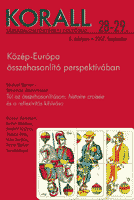Szerkezeti alapvonások a Horthy-kori Kecskemét agrártársadalmában
Key structural features of Kecskemét’s agrarian society in the Horthy period
Author(s): Zsolt SzilágyiSubject(s): History
Published by: KORALL Társadalomtörténeti Egyesület
Summary/Abstract: This paper outlines one of the possible approaches to the social structure of the agrarian society of Kecskemét market town during the interwar period. Both the chosen method, both the conceptual categories can be subject to debate, therefore in the following couple of sentences only the key connections are highlighted. It can be argued that a close connection can be identified between the town’s estate policy, the structural composition of the agrarian society and the “smoother” course of the local eff ects of the Great Depression. In Kecskemét the favourable estate relations allowed for an agrarian social structure in which the small, medium and wealthy peasant strata represented one third of the society under study. The workshops of these strata constituted the basis of the town’s horticultural economy. The fruit export enabled these workshops – even during the years of the Great Depression – to provide employment for the extremely low-income domestic servant and day labourer strata constituting the larger part of the agrarian society. Furthermore, the town operated a relatively extended “social safety net” that became one of the indispensable supports for destitute and poor families. The mobility possibilities of the society under study were fairly limited. An opportunity for upward mobility within the agrarian society was off ered by the urban leasehold system, which could be obtained under favourable conditions. Landed property, this immobile capital served as an important element of social integration, while the entrepreneurial spirit was missing from the majority of the agrarian society. Hence the diff erence in mentality can be identified – apart from a few exceptions – in investing its mobile capital in landed estates, continuing the “traditions” of the market town, as opposed to the local Jewish community, which withdrew its capital from the local landed estates compared to the 19th century situation.
Journal: Korall - Társadalomtörténeti folyóirat
- Issue Year: 2007
- Issue No: 28-29
- Page Range: 196-225
- Page Count: 30
- Language: Hungarian

